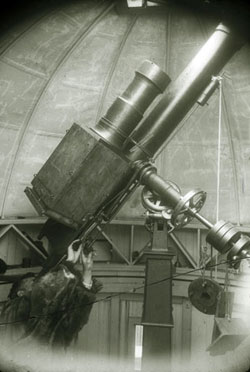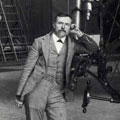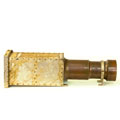

 Edward Emerson Barnard guiding the first version of his
wide-field camera.
Several of Lick's early staff astronomers made important use of photography, and indeed contributed
significantly to its development and wide acceptance as an essential observing tool. Among them
was one of the first true masters of celestial photography, Edward Emerson Barnard.
Barnard had learned photography the hard way. As a child in Nashville, Tennessee, he was forced
to leave school to support his family, taking work as a portrait photographer's assistant.
Years later, as a member of Lick's original scientific staff, Barnard combined his photographic
know-how, his consummate skill as an observer, and the fine observing conditions on
Mount Hamilton to produce breathtaking wide-field photographs of the Milky Way and
comets which stand among the great accomplishments—and most compellingly beautiful
images—in astrophotography.
Telescopes of the time had fields of view too narrow to record the
glittering fields of stars, great clouds of luminous gas, and inky regions of
dust strewn across the Milky Way. To make them visible, Barnard needed a camera
with both a wide field and substantial light grasp. He found it in the Willard lens,
made for portraiture but adapted by Barnard for celestial photography. His resulting Milky Way
photographs revealed our galaxy as it had never before been seen.
Edward Emerson Barnard guiding the first version of his
wide-field camera.
Several of Lick's early staff astronomers made important use of photography, and indeed contributed
significantly to its development and wide acceptance as an essential observing tool. Among them
was one of the first true masters of celestial photography, Edward Emerson Barnard.
Barnard had learned photography the hard way. As a child in Nashville, Tennessee, he was forced
to leave school to support his family, taking work as a portrait photographer's assistant.
Years later, as a member of Lick's original scientific staff, Barnard combined his photographic
know-how, his consummate skill as an observer, and the fine observing conditions on
Mount Hamilton to produce breathtaking wide-field photographs of the Milky Way and
comets which stand among the great accomplishments—and most compellingly beautiful
images—in astrophotography.
Telescopes of the time had fields of view too narrow to record the
glittering fields of stars, great clouds of luminous gas, and inky regions of
dust strewn across the Milky Way. To make them visible, Barnard needed a camera
with both a wide field and substantial light grasp. He found it in the Willard lens,
made for portraiture but adapted by Barnard for celestial photography. His resulting Milky Way
photographs revealed our galaxy as it had never before been seen.
Click on the thumbnails below for more on the work of E. E. Barnard.
 E. E. Barnard
E. E. Barnard
 Corona, 1889
Corona, 1889
 Willard lens
Willard lens
 Nebula in Ophiuchus
Nebula in Ophiuchus
 Comet IV 1889
Comet IV 1889
